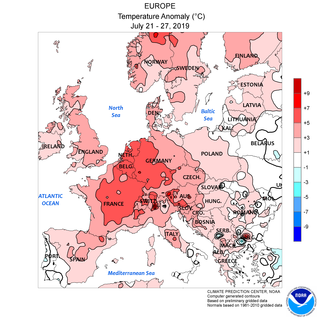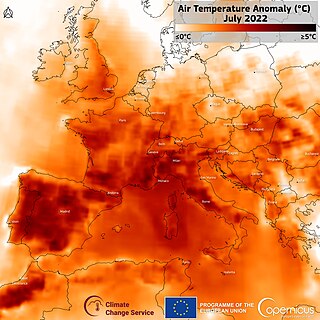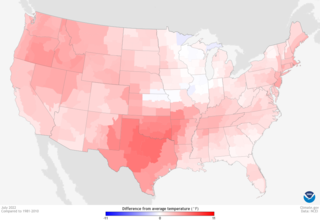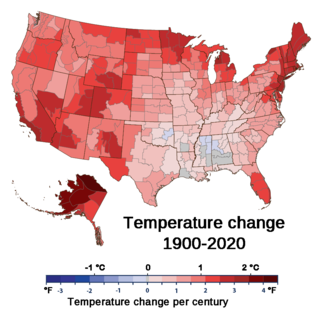This page documents notable droughts and heat waves worldwide in 2020.
Throughout the year, various countries' hottest ever recorded temperature records were broken. The highest temperature during the year was on August 16, when a weather station in Death Valley in the U.S. state of California recorded an air temperature of 129.6 °F (54.2 °C), the hottest temperature recorded globally in several decades. In June, Verkhoyansk in Russia's Far East recorded a temperature of 38 °C (100 °F), the hottest temperature ever recorded above the Arctic Circle.
On April 6, Ghana recorded its highest ever temperature –44 °C (111 °F). [1]
There were nearly 15,000 deaths in China related to extreme heat. [2] Throughout the year, various countries' hottest ever recorded temperatures were recorded across Asia, including Iraq, Lebanon, and Taiwan. [1] [3] On June 20, Verkhoyansk in Russia's Far East, recorded a temperature of 38 °C (100 °F), making it the hottest temperature ever recorded above the Arctic Circle. [1] On August 17, Japan tied the record for its hottest day when a weather station in Shizuoka Prefecture recorded a temperature of 41.1 °C (106.0 °F). [4]
Australia experienced heat waves and wildfires in November, with Sydney recording two consecutive days of temperatures over 40 °C (104 °F), marking the first ever recorded such instance in the month. Andamooka, South Australia recorded a temperature of 48 °C (118 °F). [5]
A national heat records was set in Cyprus on September 4, when Nicosia recorded a temperature of 46.2 °C (115.2 °F). [6] In Portugal, heat waves lasted from May through September, resulting in more than 310 deaths per day between June 21 to August 7. The heat caused more deaths in the summer than the COVID-19 pandemic in the country. [7] Throughout 2020, heat waves killed 2,556 people in the United Kingdom. [8] Heat waves continued in Europe through September, with Lille in northern France recording a temperature of 35.1 °C (95.2 °F) recorded on September 15. [9]
From June through the end of the year, there was a heat wave and drought across much of the central to western United States, which resulted in 45 deaths and US$5.3 billion worth of damages. The ongoing heat and drought produced record large wildfires across the region, responsible for an additional 46 deaths and US$19.4 billion in damage. On August 16, a weather station in Death Valley in the U.S. state of California recorded an air temperature of 129.6 °F (54.2 °C), the hottest temperature recorded globally in several decades. The reading was possibly the hottest air temperature ever recorded on Earth, due to uncertainty in the reliability of previous measurements. In addition, Los Angeles recorded its hottest ever temperature of 121 °F (49 °C) on September 6. [10] [11] [12] On August 11, Cuba recorded its highest ever temperature –39.3 °C (102.7 °F). [1]
On September 26, Paraguay recorded its highest ever temperature –45.5 °C (113.9 °F). [1]

A heat wave, sometimes known as extreme heat, is a period of abnormally hot weather. High humidity often accompanies heat waves. This is especially the case in oceanic climate countries. Definitions vary but are similar. A heat wave is usually measured relative to the usual climate in the area and to normal temperatures for the season. Temperatures that people from a hotter climate consider normal can be called a heat wave in a cooler area. This would be the case if the warm temperatures are outside the normal climate pattern for that area. Heat waves have become more frequent, and more intense over land, across almost every area on Earth since the 1950s. This is due to climate change.

The 2003 European heat wave saw the hottest summer recorded in Europe since at least 1540. France was hit especially hard. The heat wave led to health crises in several countries and combined with drought to create a crop shortfall in parts of Southern Europe. The death toll has been estimated at more than 70,000.

A period of unusually hot summer weather occurred in the British Isles during the summer of 1976. At the same time, there was a severe drought on the islands of Great Britain and Ireland. It was one of the driest, sunniest and warmest summers (June/July/August) in the 20th century, although the summer of 1995 is now regarded as the driest. Only a few places registered more than half their average summer rainfall. In the Central England temperature record, it was the warmest summer in the series until being surpassed in the 21st century. It was the warmest summer in the Aberdeen area since at least 1864, and the driest summer since 1868 in Glasgow.

The 2010 Northern Hemisphere summer heat waves included severe heat waves that impacted most of the United States, Kazakhstan, Mongolia, China, Hong Kong, North Africa and the European continent as a whole, along with parts of Canada, Russia, Indochina, South Korea and Japan during July 29 2010. The first phase of the global heatwaves was caused by a moderate El Niño event, which lasted from June 2009 to May 2010. The first phase lasted only from April 2010 to June 2010, and caused only moderate above average temperatures in the areas affected. But it also set new record high temperatures for most of the area affected, in the Northern Hemisphere. The second phase was caused by a very strong La Niña event, which lasted from June 2010 to June 2011. According to meteorologists, the 2010–11 La Niña event was one of the strongest La Niña events ever observed. That same La Niña event also had devastating effects in the Eastern states of Australia. The second phase lasted from June 2010 to October 2010, caused severe heat waves, and multiple record-breaking temperatures. The heatwaves began in April 2010, when strong anticyclones began to develop, over most of the affected regions, in the Northern Hemisphere. The heatwaves ended in October 2010, when the powerful anticyclones over most of the affected areas dissipated.
The 2016 Indian heat wave was a major heat wave in April and May of that year. A national record high temperature of 51.0 °C (123.8 °F) was set in the town of Phalodi, in the state of Rajasthan. Over 1,100 people died with 330 million affected to some degree. There were also water shortages with drought worsening the impact of the heat wave.

The 1995 British Isles heatwave occurred between late July and late August. It was part of one of the warmest summers recorded in the UK, and one of the warmest Augusts ever recorded in many locations around the UK, as well as being one of the driest summers ever recorded in the UK; many weather stations recorded the summer of 1995 as drier than, or comparable with, the summer of 1976. Ireland was also widely affected by the heatwave with temperatures reaching over 30 °C (86 °F) in some locations, as well as exceptionally low rainfall throughout the summer.

The 2018 Britain and Ireland heatwave was a period of unusually hot weather that took place in June, July and August. It caused widespread drought, hosepipe bans, crop failures, and a number of wildfires. These wildfires worst affected northern moorland areas around the Greater Manchester region, the largest was at Saddleworth Moor and another was at Winter Hill, together these burned over 14 square miles (36 km2) of land over a period of nearly a month.

The 2018 European drought and heat wave was a period of unusually hot weather that led to record-breaking temperatures and wildfires in many parts of Europe during the spring and summer of 2018. It is part of a larger heat wave affecting the northern hemisphere, caused in part by the jet stream being weaker than usual, allowing hot high-pressure air to linger in the same place. According to the European Drought Observatory, most of the areas affected by drought are across northern and central Europe. According to the World Meteorological Organization, the severe heat waves across the northern hemisphere in the summer of 2018, are linked to climate change in Europe, as well as events of extreme precipitation.
In 2018, several heat waves with temperatures far above the long-time average and droughts were recorded in the Northern Hemisphere: The earth's average surface temperature in 2018 was the fourth highest in the 140 years of record keeping. It is assumed that the jet stream is slowing down, trapping cloudless, windless and extremely hot regions of high pressure. The jet stream anomalies could be caused by polar amplification, one of the observed effects of global warming.

In late June and late July 2019 there were two temporally distinct European heat waves, which set all-time high temperature records in Belgium, France, Germany, Luxembourg, the Netherlands, and the United Kingdom.

The 2021 Western North America heat wave was an extreme heat wave that affected much of Western North America from late June through mid-July 2021. Extreme event attribution found this was a 1000-year weather event, made 150 times more likely by climate change. A study in Nature Climate Change estimated that its occurrence, while previously thought virtually impossible, is projected to increase rapidly with further global warming, possibly becoming a 10-yearly occurrence in a climate 2°C warming than the pre-industrial period, which may be reached by 2050 if fossil fuels are not phased out and carbon-dioxide emissions eliminated. The heat wave affected Northern California, Idaho, Western Nevada, Oregon, and Washington in the United States, as well as British Columbia, and in its latter phase, Alberta, Manitoba, the Northwest Territories, Saskatchewan, and Yukon, all in Canada. It also affected inland regions of Central and Southern California, Northwestern and Southern Nevada and parts of Montana, though the temperature anomalies were not as extreme as in the regions farther north.

In 2022, several areas of the world experienced heat waves. Heat waves were especially notable in East Asia, the Indian subcontinent, Australia, western Europe, the United States, and southern South America. 2022 heat waves accounted for record-breaking temperatures and, in some regions, heat-related deaths. Heat waves were worsened by the effects of climate change, and they exacerbated droughts and wildfires.

The 2022 United Kingdom heatwaves were part of several heatwaves across Europe and North Africa. The United Kingdom experienced three heatwaves; the first was for three days in June, the second for three days in July, and the third for six days in August. These were periods of unusually hot weather caused by rising high pressure up from the European continent. There were also more grass fires and wildfires than average, and in August a drought was declared in many regions.

From June to August 2022, persistent heatwaves affected parts of Europe, causing evacuations and a confirmed death toll of 24,501. However, upper estimates suggested more than 61,000 heat-related deaths between 30 May and 4 September. These heat waves were the deadliest meteorological events in 2022. The highest temperature recorded was 47.0 °C (116.6 °F) in Pinhão, Portugal, on 14 July.

From late spring to late summer heat waves in 2022 smashed many records in North America between May and September of that year. Dozens of temperature records were surpassed in the United States.

From June to 31 August 2022, China had a severe heat wave which affected several provinces and municipalities. To date, it is the country's worst heat wave to have existed. According to weather historian Maximiliano Herrera, it is the most severe heat wave recorded anywhere in the world.

Starting in May 2023, a heat wave affected Western North America. The heat wave entailed wildfires in Alberta, record temperatures across Canada and the US, and over 100 deaths in Mexico. The heat also accelerated snow melt in mountain ranges, causing flooding and mudslides. According to scientists, climate change increased the strength of the 2023 heatwaves including in North America.

A number of heat waves began across parts of the northern hemisphere in April 2023, many of which are ongoing. Various heat records have been broken, with July being the hottest month ever recorded.

In 2023, Europe has been affected by heat waves. The most significant of these so far has been the named heat wave, Cerberus Heatwave, which is expected to bring the hottest temperatures ever recorded in Europe. Starting on 10 July 2023, the record-breaking Cerberus anticyclone affected many European countries, with the effects felt most severely in parts of Southeast and Southwest Europe such as Cyprus, Greece, Italy, and Spain. The private Italian weather website iLMeteo named the extreme weather event after the hound of Hades from Greek mythology, and although some reports link the naming to the Italian Meteorological Society, the society's president said that they "absolutely don’t use it".